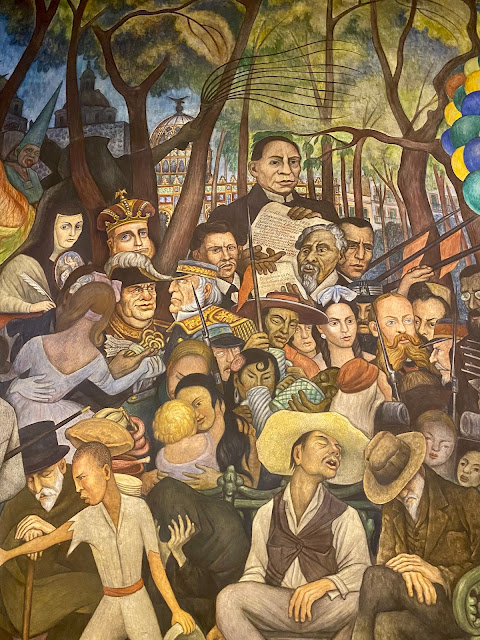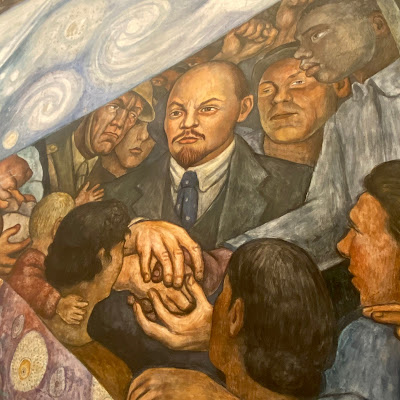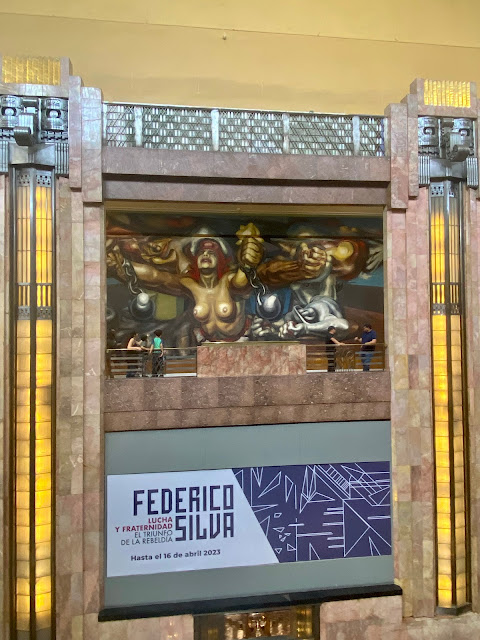Even if the Monumento a la Revolución hadn't stimulated a new obsession with Mexican history, Diego Rivera would have with "Dream of a Sunday Afternoon in Alameda Park," in which he--as a ten-year old boy--and Frida Kahlo stand front and center, alongside La Calavera Catrina and Jose Guadalupe Posada, his artistic mentor.
The fifty-foot long fresco, once housed in a hotel destroyed by the massive 1985 earthquake and rescued by Rivera's daughter with his second wife (he had four, including Frida, to whom he was married twice), it depicts 400 years of Mexican political history, left to right, from the Spanish conquest to the Porfiriato, and the 1910 revolution.
There's liberal Juarez again, clutching the country's first constitution, with the unbuilt Parliament building behind him, standing much taller than Empress Carlota and Emperor Maximillian, a pair of European nobles who were invited by conservatives to reign over Mexico in 1864. Bad move for the House of Hapsburg: three years later, a firing squad executed Maximillian (an execution depicted by Edouard Manet) and Carlota fled to Paris, where she lived another six decades, much of it in madness. You can't make this stuff up!
Or leave Mexico City without being awed by the incredible talent of Rivera, sculpted here by Antonio Castellanos.
Afterward we headed to Alameda Park itself, detouring briefly to see the Basilica of San Hipolito, a 16th century baroque church built upon the site of a battle between the Aztecs and the Spanish, The colonialists were led by a Black conquistador who also just happens to have been the first documented person of African descent to have visited what became the United States.Mass on a Sunday afternoon was standing room only.
Thanks to Netflix and Atlas Obscura, we also tracked down this rather sad brass plaque--featuring two nude men--commemorating the Dance of the Forty One during the Porfiriato.
Mexican families have been spending their Sundays in Alameda Park since 1592. It's the oldest park in the Americas.
Porfirio Díaz commissioned this monument to honor the centenary of Benito Juarez's birth in 1906. His own presidency would last only another four years.
It's very hard for me to understand my lack of curiosity about this great leader given the fact that I visited the city named for him many times when I lived in El Paso. Shame on me--call this an atonement selfie!
Just behind the monument a dozen or so women were knitting a project they call "Blood of My Blood," to call attention to the hundreds of Mexicans who vanish without a trace every year.
They planned to pressure the government into investigating these crimes by exhibiting their creation during International Women's Day the following Wednesday in the Plaza de la Constitucion. The massive event threatened to shut down the Centro Historico.
We ended our afternoon at the Palace of Fine Arts at the eastern end of Alameda Park.
Mexico's most famous muralists decorated the walls of the stunning Art Deco interior.
For the second time that day we were blown away by another vibrant Diego Rivera masterwork. It stretches across one end of the upper floor and has a fascinating provenance.
The Rockefeller family commissioned "Man at the Crossroads" to adorn the lobby wall of 30 Rock.
But Nelson Rockefeller, apocryphally rumored by some to be the titular model, balked when Rivera featured Vladimir Lenin in a fresco that would be associated with America's grandest capitalist temple. Rockefeller had the mural removed, although he and Rivera remained friends.
Rivera reconstituted the fresco in Mexico City's Palace of Fine Arts which opened in 1934. He changed the title to "Man Controller of the Universe" and added comrades Karl Marx, Friedrich Engels and Leon Trotsky. I gotta tell ya, they look like bit players to me!
It's hard to image a performing arts institution in the U.S. giving José Clemente Orozco license to create a mural as intense as "Katharsis."
But even it pales beside the frescoes that firebrand David Alfaro Siquerios painted.
In "New Democracy" Siquerios celebrates the victory of democracy over totalitarianism.Here, in an inspiring bit of propaganda intended to evoke pride among Mexico's indigenous citizens, Siquerios glorifies Cuauhtémoc, the last Aztec emperor, as a fierce, armored warrior. Check out his club!
But in this grotesque depiction of the conquest of Mesoamerica, Siquerios illustrates extreme Spanish cruelty. The colonialists are burning the feet of of Cuauhtémoc and one of his allies.
It's hard not to think of this attack dog as the artist himself, a committed Stalinist who plotted to assassinate Leon Trotsky four centuries later. We criticize our own shortcomings in others.
Rivera's social commentary, even in frescoes like these inspired by Mexican carnivals, relies more on allegory and is just as trenchant, if less bloodthirsty.
We exited the palace exhilarated, beneath this beautiful window grill.































No comments:
Post a Comment